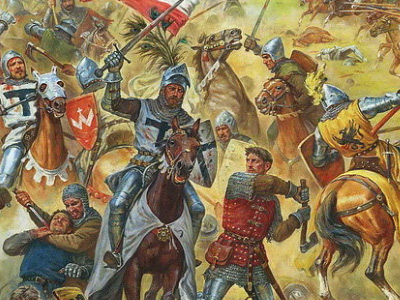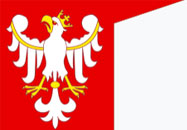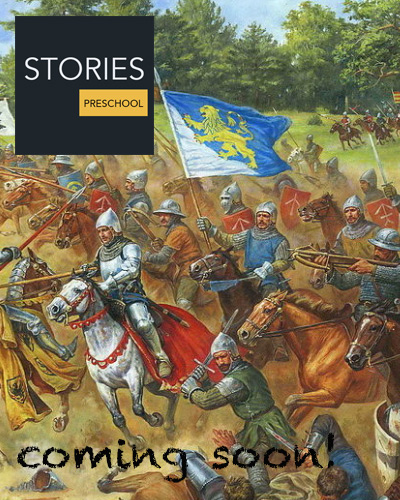Battle of Grunwald (1410)
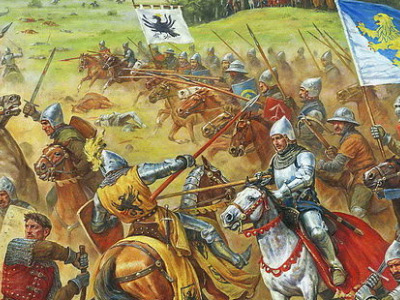
Aftermath
Casualties and Captives
A note sent in August 1410 by envoys of King Sigismund of Hungary, Nicholas II Garai and Stibor of Stiboricz, put total casualties at 8,000 dead "on both sides". However, the wording is vague and it is unclear whether it meant a total of 8,000 or 16,000 dead. A papal bull from 1412 mentioned 18,000 dead Christians. In two letters written immediately after the battle, Władysław II Jagiełło mentioned that Polish casualties were small (paucis valde and modico) and Jan Długosz listed only 12 Polish knights that were killed. A letter by a Teutonic official from Tapiau (Gvardeysk) mentioned that only half of the Lithuanians returned, but it is unclear how many of those casualties are attributable to the battle and how many to the later siege of Marienburg.
The defeat of the Teutonic Knights The Teutonic Order is a Catholic religious institution founded as a military society c. 1190 in Acre, Kingdom of Jerusalem. The Order of Brothers of the German House of Saint Mary in Jerusalem was formed to aid Christians on their pilgrimages to the Holy Land and to establish hospitals. Its members have commonly been known as the Teutonic Knights, having a small voluntary and mercenary military membership, serving as a crusading military order for the protection of Christians in the Holy Land and the Baltics during the Middle Ages. was resounding. According to Teutonic payroll records, only 1,427 men reported back to Marienburg to claim their pay. Of 1,200 men sent from Danzig, only 300 returned. Between 203 and 211 brothers of the Order were killed, out of 270 that participated in battle, including much of the Teutonic leadership—Grand Master Ulrich von Jungingen, Grand Marshal Friedrich von Wallenrode, Grand Komtur Kuno von Lichtenstein, Grand Treasurer Thomas von Merheim, Marshal of Supply Forces Albrecht von Schwartzburg, and ten of the komturs. Markward von Salzbach, Komtur of Brandenburg (Ushakovo) and Heinrich Schaumburg, voigt of Sambia, were executed by order of Vytautas after the battle. The bodies of von Jungingen and other high-ranking officials were transported to Marienburg Castle for burial on 19 July. The bodies of lower-ranking Teutonic officials and 12 Polish knights were buried at the church in Tannenberg. The rest of the dead were buried in several mass graves. The highest-ranking Teutonic official to escape the battle was Werner von Tettinger, Komtur of Elbing (Elbląg).
The Teutonic Order is a Catholic religious institution founded as a military society c. 1190 in Acre, Kingdom of Jerusalem. The Order of Brothers of the German House of Saint Mary in Jerusalem was formed to aid Christians on their pilgrimages to the Holy Land and to establish hospitals. Its members have commonly been known as the Teutonic Knights, having a small voluntary and mercenary military membership, serving as a crusading military order for the protection of Christians in the Holy Land and the Baltics during the Middle Ages. was resounding. According to Teutonic payroll records, only 1,427 men reported back to Marienburg to claim their pay. Of 1,200 men sent from Danzig, only 300 returned. Between 203 and 211 brothers of the Order were killed, out of 270 that participated in battle, including much of the Teutonic leadership—Grand Master Ulrich von Jungingen, Grand Marshal Friedrich von Wallenrode, Grand Komtur Kuno von Lichtenstein, Grand Treasurer Thomas von Merheim, Marshal of Supply Forces Albrecht von Schwartzburg, and ten of the komturs. Markward von Salzbach, Komtur of Brandenburg (Ushakovo) and Heinrich Schaumburg, voigt of Sambia, were executed by order of Vytautas after the battle. The bodies of von Jungingen and other high-ranking officials were transported to Marienburg Castle for burial on 19 July. The bodies of lower-ranking Teutonic officials and 12 Polish knights were buried at the church in Tannenberg. The rest of the dead were buried in several mass graves. The highest-ranking Teutonic official to escape the battle was Werner von Tettinger, Komtur of Elbing (Elbląg).
Polish and Lithuanian forces took several thousand captives. Among these were Dukes Konrad VII of Oels (Oleśnica) and Casimir V of Pomerania. Most of the commoners and mercenaries were released shortly after the battle on condition that they report to Kraków on 11 November 1410. Only those who were expected to pay ransom were kept. Considerable ransoms were recorded; for example, the mercenary Holbracht von Loym had to pay 150 kopas of Prague groschen, amounting to more than 30 kg (66 lb) of silver.
Further Campaign and Peace
After the battle, the Polish and Lithuanian forces delayed their attack on the Teutonic capital in Marienburg (Malbork), remaining on the battlefield for three days and then marching an average of only about 15 km (9.3 mi) per day. The main forces did not reach heavily fortified Marienburg until 26 July. This delay gave Heinrich von Plauen enough time to organize a defense. Władysław II Jagiełło also sent his troops to other Teutonic fortresses, which often surrendered without resistance, including the major cities of Danzig (Gdańsk), Thorn (Toruń), and Elbing (Elbląg). Only eight castles remained in Teutonic hands. The besiegers of Marienburg expected a speedy capitulation and were not prepared for a long siege, suffering from lack of ammunition, low morale and an epidemic of dysentery. The Knights appealed to their allies for help, and Sigismund of Hungary, Wenceslaus, King of the Romans, and the Livonian Order promised financial aid and reinforcements.
The siege of Marienburg was lifted on 19 September. The Polish–Lithuanian forces left garrisons in the fortresses they had taken and returned home. However, the Knights quickly recaptured most of the castles. By the end of October only four Teutonic castles along the border remained in Polish hands. Władysław II Jagiełło raised a fresh army and dealt another defeat to the Knights in the Battle of Koronowo on 10 October 1410. Following other brief engagements, both sides agreed to negotiate.
The Peace of Thorn was signed in February 1411. Under its terms, the Knights ceded the Dobrin Land (Dobrzyń Land) to Poland and agreed to resign their claims to Samogitia during the lifetimes of Władysław II Jagiełło and Vytautas, although another two wars—the Hunger War of 1414 and the Gollub War of 1422—would be waged before the Treaty of Melno permanently resolved the territorial disputes. The Poles and Lithuanians were unable to translate the military victory into territorial or diplomatic gains. However, the Peace of Thorn imposed a heavy financial burden on the Knights from which they never recovered. They had to pay an indemnity in silver, estimated at ten times the annual income of the King of England The Kingdom of England was a sovereign state on the island of Great Britain from about 927, when it emerged from various Anglo-Saxon kingdoms, until 1 May 1707, when it united with Scotland to form the Kingdom of Great Britain. The Viking invasions of the 9th century upset the balance of power between the English kingdoms, and native Anglo-Saxon life in general. The English lands were unified in the 10th century in a reconquest completed by King Æthelstan in 927., in four annual installments. To meet these payments, the Knights borrowed heavily, confiscated gold and silver from churches and increased taxes. Two major Prussian cities, Danzig (Gdańsk) and Thorn (Toruń), revolted against the tax increases. The defeat at Grunwald left the Teutonic Knights with few forces to defend their remaining territories. Since Samogitia became officially christened, as both Poland and Lithuania were for a long time, the Knights had difficulties recruiting new volunteer crusaders. The Grand Masters then needed to rely on mercenary troops, which proved an expensive drain on their already depleted budget. The internal conflicts, economic decline, and tax increases led to unrest and the foundation of the Prussian Confederation, or Alliance against Lordship, in 1441. This in turn led to a series of conflicts that culminated in the Thirteen Years' War (1454).
The Kingdom of England was a sovereign state on the island of Great Britain from about 927, when it emerged from various Anglo-Saxon kingdoms, until 1 May 1707, when it united with Scotland to form the Kingdom of Great Britain. The Viking invasions of the 9th century upset the balance of power between the English kingdoms, and native Anglo-Saxon life in general. The English lands were unified in the 10th century in a reconquest completed by King Æthelstan in 927., in four annual installments. To meet these payments, the Knights borrowed heavily, confiscated gold and silver from churches and increased taxes. Two major Prussian cities, Danzig (Gdańsk) and Thorn (Toruń), revolted against the tax increases. The defeat at Grunwald left the Teutonic Knights with few forces to defend their remaining territories. Since Samogitia became officially christened, as both Poland and Lithuania were for a long time, the Knights had difficulties recruiting new volunteer crusaders. The Grand Masters then needed to rely on mercenary troops, which proved an expensive drain on their already depleted budget. The internal conflicts, economic decline, and tax increases led to unrest and the foundation of the Prussian Confederation, or Alliance against Lordship, in 1441. This in turn led to a series of conflicts that culminated in the Thirteen Years' War (1454).
HISTORY
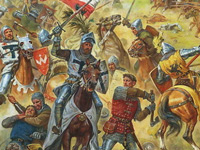
RESOURCES
This article uses material from the Wikipedia article "Battle of Grunwald (1410)", which is released under the Creative Commons Attribution-Share-Alike License 3.0.
© Stories Preschool. All Rights Reserved.
